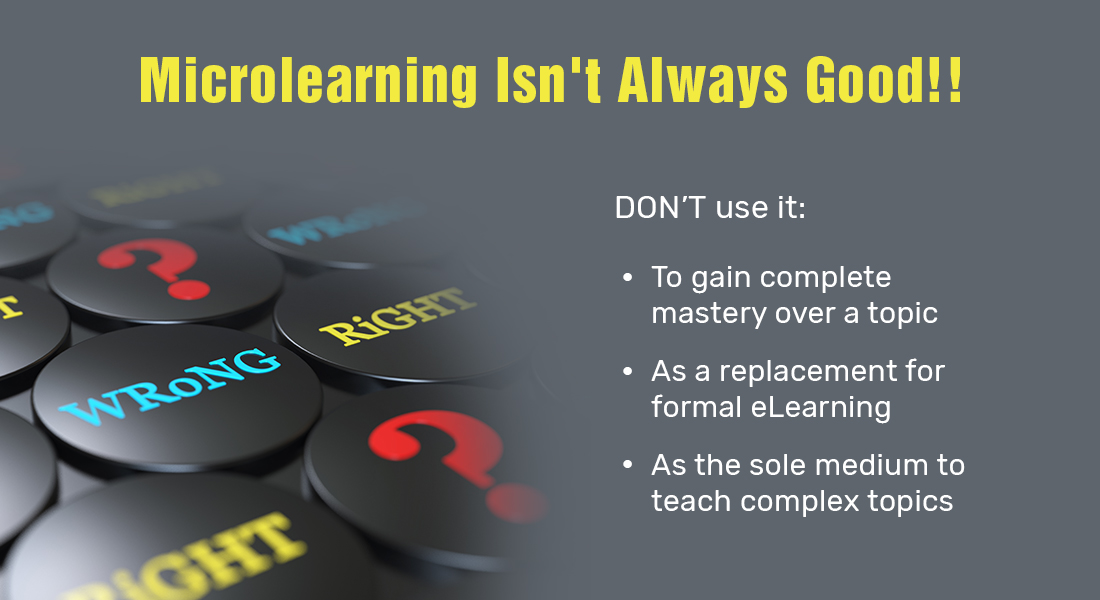The Other Side of Microlearning: When NOT to Use It

Microlearning.
As the name suggests, it is a strategy to deliver training content to learners in small doses or bursts. It’s also called ‘bite-sized learning’. Not that I need to introduce you to microlearning – after all, microlearning has proven itself to be a smart training strategy that can not only effectively engage learners and reinforce learning but also reduce training development cost and turnaround time.
When Should you Say NO to Microlearning?
- Using it just because it’s trendy
- Using it to tackle complex concepts
- Using it to gain mastery over a subject
- Using it to replace eLearning
Learn the secret of reducing development cost and time with rapid eLearning.
Microlearning has become especially popular in recent times, which witnessed a growing need for ‘quick-fix but effective’ training solutions for new-age learners. So much so that most training programs nowadays include microlearning in some form or the other, be it for pre-training introductions, as standalone courses for quick information, as part of a curriculum, or for performance support.

With such versatility, it is hard to find anything against microlearning. However, though microlearning is quite useful and effective when used in specific situations, it can also do more harm than good in other instances. In this blog, we’ll discuss a few instances when you should NOT use microlearning.
4 Situations When you Should NOT Use Microlearning
1. DON’T Use Microlearning Just Because it’s Trendy
Microlearning is indeed a very popular learning strategy and there are numerous research articles that highlight how successful it is in engaging learners and knowledge retention. But a word of caution here – do not go by these trends alone. Microlearning is an effective solution when it is planned and implemented correctly and most importantly, only when the training truly calls for it.
Microlearning follows a very important principle, ‘form follows function’. ‘Form follows function’ is a principle associated with architecture and industrial design – that the shape of a building or object should be primarily based on its intended function or purpose.
In the same way, in microlearning, the purpose of a course/asset should guide its design and not the other way around. So if you want to highlight the dos and don’ts of handling equipment, an infographic might be the right choice compared to an eBook. Similarly, if you want to use microlearning to help learners troubleshoot a machine, a video is a better choice compared to a scenario-based game.
Ensure you zero in on the intended performance outcomes from the microlearning asset and then decide on its format.
2. DON’T Use Microlearning to Tackle Complex Concepts
Online corporate training involves training employees on a myriad of subjects and topics that are often highly technical and complex. Microlearning may not be the best format to deliver training on such topics.
What this means is this. You can’t expect your learners to become experts on handling a complex piece of machinery safely after going through a standalone 10-minute microlearning course. This will require learners to have sound theoretical knowledge of the machine and hands-on experience in using it. So microlearning can be used as part of a blend to offer practice opportunities in spaced intervals, to reinforce practical skills, or a job-aids.
And it’s not only about technical subjects, any topic that needs to be taught in a continuous flow and does not make sense when it is chunked and taught in intervals, does not qualify for conversion to microlearning. For example, if there is a sales process of 5 steps, conveying each step as a micro module doesn’t make sense as learners need to go through the steps in sequence, at once. And for compliance training programs that learners need to be certified on, microlearning can also be used for reinforcement.
3. DON’T Use Microlearning for Mastery Over a Subject
It is often expected that with microlearning, everything can be learned quickly, but is that really true? You can’t become an exceptional manager by watching a 5-minute video. You can’t become a charismatic salesperson or cultivate really good communication skills to deal with disgruntled customers through a micro solution. More often than not, microlearning gives you just enough information to perform well at the point of need but not enough to become a master.
Let’s say you want your software developers to learn a new programming language, you can’t give them a few 10-minute courses and expect them to muddle through on their own. Even if some of them do develop some skills to work with this new programming language, their knowledge will only be passable, not masterful.
Mastery requires macrolearning. But that doesn’t necessarily mean going back to school – classroom training, full-length eLearning courses, or some blended learning combination of the two can do the trick. But, to become a great manager or master any new skill, you need to dedicate time and practice continuously. The more you apply your skills, the more you learn.
4. DON’T Use Microlearning as a Replacement for eLearning
A while ago, I read this insightful little article on microlearning pros and cons. It said microlearning is like taking an aspirin for your headache, it can be a quick fix for a simple nuisance or just mask away a greater problem. What it means is that microlearning solutions are a quick-fix solution when you are stuck with a problem and need immediate information to solve it, but it can also hide a larger knowledge gap. That is why macrolearning in the form of eLearning has its undisputed place in corporate training and microlearning is used to supplement already learned knowledge.
I often come across people saying that microlearning will gradually replace eLearning or is already doing so. Or how microlearning can be a one-stop solution to every training woe. That is as far from the truth as you can get. To better understand why microlearning can’t replace eLearning, let’s flip this argument that is often given to advocate microlearning.
If have to choose between one 40 minutes long eLearning course and four 10 minutes long microlearning modules, what will you choose? The latter, of course! However, chunking eLearning courses into small modules isn’t the solution to cater to learner preferences. Use micro assets for pieces of content that make sense such as dos and don’ts, steps, and technical terms.
For the rest, a complete eLearning course will give learners a composite view – with the option of visiting the learning point of their choice (if open navigation is allowed, an important adult learning principle).
Do you now appreciate that microlearning can’t always be your go-to solution? Both eLearning and microlearning have their own unique strengths and one can’t replace another.
Summing it Up!
How did you find this blog? Did it force you to re-evaluate some of your ideas about microlearning? Like I said in the beginning, it is hard to find real disadvantages of a solution as versatile and as easy as microlearning. It is only when we force it to solve every training problem, does it become a real problem. Microlearning is an elegant and effective solution for a lot of training challenges, but it does have its limitations. It is not a cure for all ailments, even though many try to make it out to be one.
If you want to know the real scope of microlearning and how it can be implemented in corporate training design, download our eBook.
Editor’s note: This post was originally published in August 2020 and has been updated for comprehensiveness.





